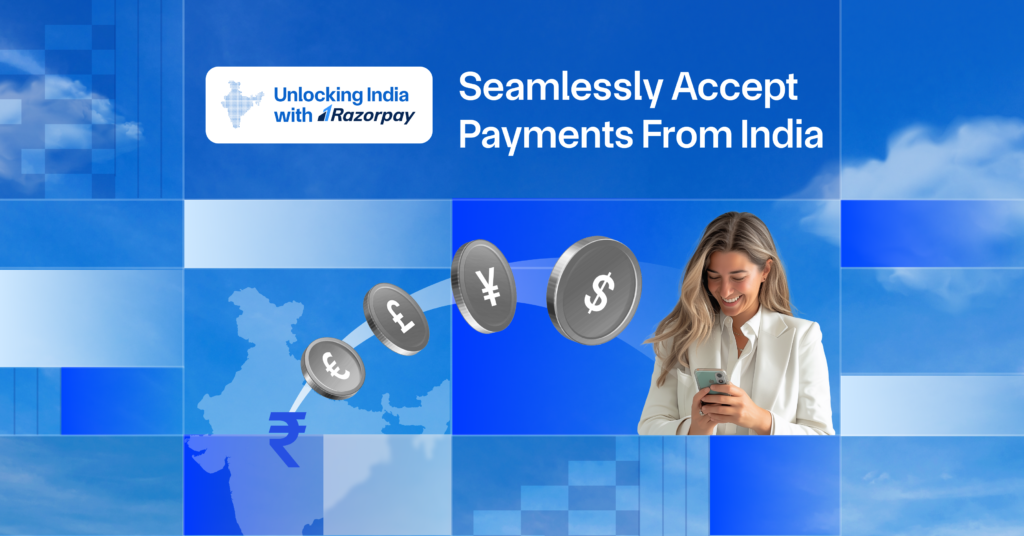India is one of the fastest-growing digital economies, with millions of consumers shopping online every day. However, for international businesses looking to sell in India, accepting payments from Indian customers can be a challenge.
Unlike Western markets, where credit cards dominate, India is a UPI-first country. UPI (Unified Payments Interface) now accounts for 80% of all digital transactions, and RuPay—India’s domestic card network—is rapidly expanding, especially after enabling credit on UPI.
If your business doesn’t support these local payment methods, you risk losing out on a huge market. This guide will show you how to seamlessly accept payments from Indian customers and grow your business in India.
1. The Challenge: Why Accepting Payments from India is Difficult
Global SaaS companies and payment service providers (PSPs) targeting Indian customers often encounter unique challenges. Below, we explore three key factors: the dominance of UPI (Unified Payments Interface), the rise of RuPay (India’s homegrown card network), and high failure rates for international card payments.
UPI’s Dominance
UPI has utterly transformed how Indians pay. Launched in 2016, UPI quickly grew to become the most-used payment method in the country, powering over 15 billion transactions per month as of late 2024. By the end of 2024, UPI accounted for 83% of total digital payment volume in India – a massive leap from just 34% in 2019. UPI’s ease of use (mobile-first, instant, zero-fee for consumers) has made it ubiquitous for everyday purchases. It’s the default payment method for everything from splitting bills with friends to buying groceries. In online commerce too, UPI reigns supreme, carrying 55% of e-commerce transaction volume in India and growing ~18% annually. Sectors like streaming services, travel booking, and online retail see a majority of Indian transactions via UPI.
The problem? Most international merchants do not support UPI at checkout, despite it being the preferred way for Indians to pay. An Indian customer on a foreign SaaS or e-commerce site is often limited to cards or maybe PayPal – but not UPI. This gap has real business impact: Indian shoppers who can’t pay the way they want often abandon their purchase. Studies show 21% of shoppers will abandon carts if their preferred payment method isn’t available. For millions of Indians, that preferred method is UPI. In other words, not offering UPI means turning away a large chunk of potential conversions in India.
The Rise of RuPay – India’s Own Card Network
Alongside UPI, India has been nurturing its indigenous card scheme: RuPay. Launched in 2012 by the National Payments Corporation of India (NPCI), RuPay was envisioned as India’s answer to Visa and Mastercard. Over the past decade, RuPay has achieved widespread issuance, especially for debit cards. As of early 2024, there were over 628 million RuPay cards in circulation (debit, credit, and prepaid combined). RuPay now dominates the debit card market by card count, with well above 60% market share in number of cards issued. In practice, this means a huge portion of Indian bank account holders – especially first-time entrants to the banking system – are given RuPay debit cards as their default card.
Although RuPay’s presence in credit cards was relatively low, the picture is changing. In 2022, the RBI permitted linking RuPay credit cards to UPI, which turned out to be a game-changer for RuPay. This integration effectively turned every UPI QR code into an acceptance point for RuPay credit cards, vastly expanding where they can be used. The impact has been dramatic: RuPay’s share of the credit card market (by transaction volume) jumped from around 3% in FY2023 to about 10% in FY2024, and rose to roughly 12% by late 2024.
Industry data shows RuPay credit cards are being used very frequently via UPI (users average 21 transactions a month on credit via UPI, about 4× the usage of a typical credit card). Moreover, nearly 20% of all new credit cards issued in India are now virtual cards linked via UPI.
Why does this matter to global companies and PSPs? Because a growing share of Indian customers may possess only a RuPay card or prefer using it, and if your payment stack doesn’t support RuPay, you’re shutting them out. A student or a consumer with a RuPay debit card often cannot use it on a foreign website that only accepts Visa/Mastercard. Businesses not supporting RuPay (either by failing to accept RuPay cards or by not integrating UPI) risk losing out on a large customer segment. As RuPay’s share in both debit and credit grows, this gap will only widen.
Card Payment Failures
Even when Indian customers try to pay with international cards, transaction success rates in cross-border scenarios are relatively lower. It’s not uncommon for global merchants to see higher decline rates on Indian cards. Several factors drive this:
Mandatory OTP authentication (2FA): Any domestic online card purchase must go through an Additional Factor of Authentication – typically a one-time password (OTP) sent to the cardholder’s phone. While this has reduced fraud, it also adds friction and points of failure. Customers might abandon the transaction when prompted for an OTP or if the 3-D Secure page takes too long. If the OTP SMS is delayed or never arrives, the payment fails.
Bank-imposed restrictions on international usage: To combat fraud, Indian banks tend to be conservative with foreign or cross-border charges. In some cases, international transactions are disabled by default and the customer must explicitly request or toggle on international capability before the card works overseas. If a customer hasn’t done this, any attempt to charge the card in a foreign currency will be rejected immediately.
The net result is that even well-intentioned Indian customers trying to pay a global merchant can face obstacles. From a merchant’s perspective, this translates to lost revenue.
Without native OTP support, international businesses often experience low success rates on card payments.
2. The Solution: How to Accept Payments from Indian Customers
A. Accept UPI – India’s #1 Payment Method
If you want to succeed in India, you need to accept UPI payments. Supporting UPI enables you to:
✔ Tap into 500M+ UPI users
✔ Enable subscriptions with UPI Autopay, making recurring payments easy
✔ Accept UPI payments via RuPay credit cards, opening access to a new segment of buyers
B. Accept RuPay Debit and Credit Cards
By enabling RuPay payments, your business can cater to millions of Indian customers who prefer this card network. Supporting RuPay ensures:
✔ Higher transaction success rates compared to international card networks
✔ Seamless payments for a wider audience
C. Settle INR Payments in Your International Bank Account
One of the biggest hurdles for international businesses is handling INR payments. With Razorpay Import Flow, you can:
✔ Accept payments in INR from Indian customers
✔ Settle them in your international bank account in USD, EUR, GBP, or any preferred currency
✔ Avoid the hassle of setting up a local entity in India
D. Improve Payment Success Rates with a Localized Solution
To avoid failed transactions, you need a solution that:
✔ Uses an in-house UPI switch for the highest UPI success rates
✔ Supports native OTP authentication to reduce credit card failures
3. How Razorpay Import Flow Solves These Challenges
Razorpay Import Flow is the easiest way for international businesses to seamlessly accept INR payments without a local entity.
🔹 Accept UPI payments, including UPI Autopay for subscriptions
🔹 Enable RuPay card payments to maximize conversion rates
🔹 Receive settlements in your preferred international currency
🔹 Ensure the highest payment success rates with our in-house UPI switch and OTP authentication
Conclusion
If you’re a global business looking to sell in India, offering the right payment methods is crucial. Indian consumers expect UPI and RuPay—if you don’t support them, you’re missing out.
With Razorpay Import Flow, you can:
✅ Accept UPI, RuPay, and card payments effortlessly
✅ Settle INR earnings in your international bank account
✅ Maximize success rates and increase conversions



